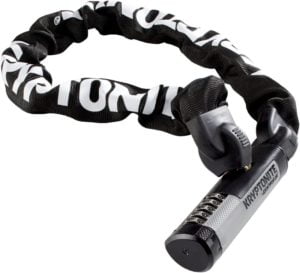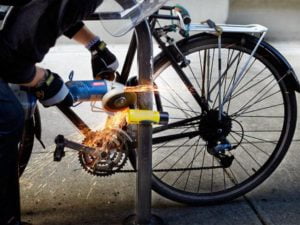Looking for decent security but worried you’ll misplace or lose your keys? A combination bike lock could be your answer!
Table of Contents
What is a combination lock?
A combination lock replaces the traditional key with a tumbler of numbers. This means you just have to remember your pin rather than your keys to be able to open and close the lock.
A 3-digit tumbler, with numbers from 0 to 9 has around 1,000 different combinations. Whereas adding just one more digit, to make it a 4 digit tumbler, increases the different permutations to almost 10,000.
Are combinations locks secure?
The security of this type of lock is less about the locking method and more about what the lock type is.
For example, a flexible metal threaded cable, known as a bicycle cable lock is a common bike lock that comes with a combination lock. These are flexible because they are constructed from a large number of tiny metal inter-twined cables which make up one larger cable, coated in plastic or ruber. However they actually offer very little protection for your bike.
Cable locks shouldn’t be your primary lock. They can be broken with just a simple pair of wire cutters.
There are no cable locks with a Sold Secure rating, however you can get other types of combination lock and combination padlock which offer good levels of security.
Combination Cable Locks

Your local bicycle shop will no doubt sell a range of combination cable locks.
As mentioned in other areas of this guide, these are easy for thieves to bypass. I would only recommend one as a ‘cafe lock’ (where you’re parking your bike in close proximity, within your view) or as a lock to secure your front wheel or helmet to your bike.
You can buy these from retailers such as Argos and even places like Lidl and Aldi sell them. Just be aware that they’re next to useless as a means of primary bicycle security.
Combination D-Locks

A combination D-lock is a decent choice as your primary means of security. The only real Achilles heel is leaving it in a place where a thief has the time to rattle through the combinations.
You can get combinations D-locks that have been tested and rated by Sold Secure
Combination Bicycle Chain Locks

A couple of security manufacturers sell chains that have a built-in lock with a combination.
However a better solution might be to couple a really chunky security chain with a decent combination padlock such as a shutter lock. That way you’re not limited to the handful of manufacturers who produce a lock and chain combo and you can build your own high-level of security with added the added flexibility or being able to use the chain and padlock independently.
Combination Bicycle Folding Locks

Folding locks offer a good middle-ground between the security of a D-lock with the flexibilty of a chain or cable lock.
They are portable and most come with a bracket that allows you to attach it to your bicycle’s frame. However I carry mine with me in my rucksack.
You can get keyed or keyless combination lock versions. The security level of these are comparable. It’s unlikely the thief will attack the locking mechanism of either type of lock. Instead, they’ll attempt to cut through, or twist to break the locking plates.
Abus are a quality manufacturer or security products and they sell the Bordo combination, which is an excellent bit of kit.
Sold Secure Combination Locks

Independent security testing organisation, Sold Secure, test locks using real-world methods in order to see how good they are.
They have tested and awarded ratings to bicycle security that uses a combination lock rather than a keyed lock, proving that these locks do have a role to play when it comes to securing your bike.
The products they have rated are outlined in the table below:
Where can you buy a combination bike lock?
I bet every local bicycle shop around the country that has a range of locks in their shop will have a combination lock dangling somewhere.
They are seriously common but hopefully you’ll have seen from the above that combination cable locks are best avoided if at all possible.
If you are going to opt for a lock that comes with a combination code as standard, think hard about whether or not it’s up to the job as acting as your primary security.
You can buy combination bike locks from well-known high-street retailers such as Argos, Halfords, Screwfix and Toolstation.
You’ll also find them at the main online retailers. In this guide I’ve selected a few different locks worth looking at and linked directly to them to make it easy for you to buy the one that will work for you.
Combination bicycle locks: a better solution?

If you want to use a combination lock as your main form of security but you don’t think the locks that have been tested by Sold Secure are good enough, then why not make your own combination?
It’s simple. Just buy a high-quality security chain and pair it with a high-quality combination padlock.
If you want portable security, then aim for something around the 10mm to 11mm thickness. Buy from a decent brand, rather than an eBay or Amazon cheapy. Have a look at chains from Abus, Pragmasis or Kryptonite.
Then match it up with a really good quality combination padlock. Something like this Squire CBW85 will do the job nicely.
Each of these products is individually rated by Sold Secure. So use them together and you’ve got a… (pardon the pun..) winning combination!
Combination Bicycle Lock FAQs
Are combination bike locks safe?
How do I reset a combination bicycle lock?
How do you open a combination lock if you forgot the code?
How do you unlock a 3 digit combination lock?
Is there a bike lock that Cannot be cut?
Is key or combo bike lock better?
Are combination locks easy to pick?
Which cycle lock is best?
Is a combination lock safer than a key lock?
Sources
Thanks to the following websites who helped us research and publish this guide to the best combination bicycle locks:
Steer clear of cycle theft (norfolk.police.uk)
Smart lock for bike sharing in corporate environments (core.ac.uk)
